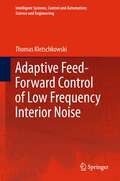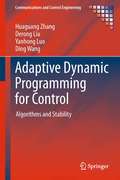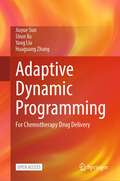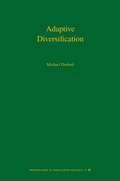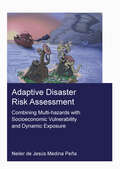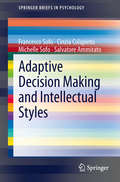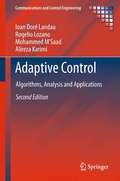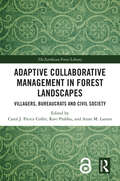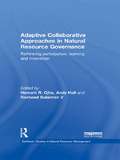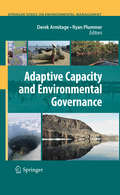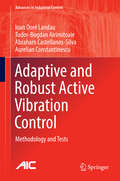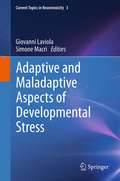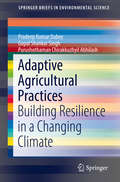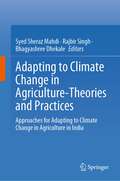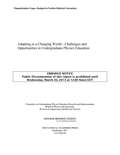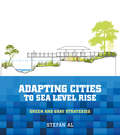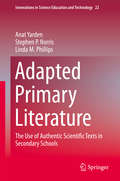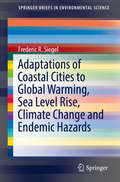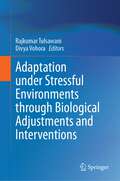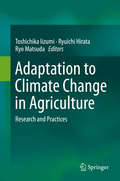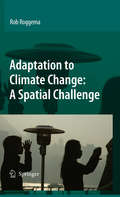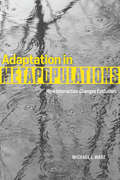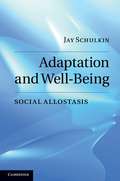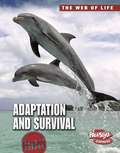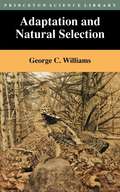- Table View
- List View
Adaptive Feed-Forward Control of Low Frequency Interior Noise (Intelligent Systems, Control and Automation: Science and Engineering #56)
by Thomas KletschkowskiThis book presents a mechatronic approach to Active Noise Control (ANC). It describes the required elements of system theory, engineering acoustics, electroacoustics and adaptive signal processing in a comprehensive, consistent and systematic manner using a unified notation. Furthermore, it includes a design methodology for ANC-systems, explains its application and describes tools to be used for ANC-system design. From the research point of view, the book presents new approaches to sound source localization in weakly damped interiors. One is based on the inverse finite element method, the other is based on a sound intensity probe with an active free field. Furthermore, a prototype of an ANC-system able to reach the physical limits of local (feed-forward) ANC is described. This is one example for applied research in ANC-system design. Other examples are given for (i) local ANC in a semi-enclosed subspace of an aircraft cargo hold and (ii) for the combination of audio entertainment with ANC.
Adaptive Dynamic Programming for Control: Algorithms and Stability (Communications and Control Engineering)
by Yanhong Luo Huaguang Zhang Ding Wang Derong LiuThere are many methods of stable controller design for nonlinear systems. In seeking to go beyond the minimum requirement of stability, Adaptive Dynamic Programming in Discrete Time approaches the challenging topic of optimal control for nonlinear systems using the tools of adaptive dynamic programming (ADP). The range of systems treated is extensive; affine, switched, singularly perturbed and time-delay nonlinear systems are discussed as are the uses of neural networks and techniques of value and policy iteration. The text features three main aspects of ADP in which the methods proposed for stabilization and for tracking and games benefit from the incorporation of optimal control methods: * infinite-horizon control for which the difficulty of solving partial differential Hamilton-Jacobi-Bellman equations directly is overcome, and proof provided that the iterative value function updating sequence converges to the infimum of all the value functions obtained by admissible control law sequences; * finite-horizon control, implemented in discrete-time nonlinear systems showing the reader how to obtain suboptimal control solutions within a fixed number of control steps and with results more easily applied in real systems than those usually gained from infinite-horizon control; * nonlinear games for which a pair of mixed optimal policies are derived for solving games both when the saddle point does not exist, and, when it does, avoiding the existence conditions of the saddle point. Non-zero-sum games are studied in the context of a single network scheme in which policies are obtained guaranteeing system stability and minimizing the individual performance function yielding a Nash equilibrium. In order to make the coverage suitable for the student as well as for the expert reader, Adaptive Dynamic Programming in Discrete Time: * establishes the fundamental theory involved clearly with each chapter devoted to a clearly identifiable control paradigm; * demonstrates convergence proofs of the ADP algorithms to deepen understanding of the derivation of stability and convergence with the iterative computational methods used; and * shows how ADP methods can be put to use both in simulation and in real applications. This text will be of considerable interest to researchers interested in optimal control and its applications in operations research, applied mathematics computational intelligence and engineering. Graduate students working in control and operations research will also find the ideas presented here to be a source of powerful methods for furthering their study.
Adaptive Dynamic Programming: For Chemotherapy Drug Delivery
by Jiayue Sun Shun Xu Yang Liu Huaguang ZhangThis open access book focuses on the practical application of Adaptive Dynamic Programming (ADP) in chemotherapy drug delivery, taking into account clinical variables and real-time data. ADP's ability to adapt to changing conditions and make optimal decisions in complex and uncertain situations makes it a valuable tool in addressing pressing challenges in healthcare and other fields. As optimization technology evolves, we can expect to see even more sophisticated and powerful solutions emerge.
Adaptive Diversification (Monographs in Population Biology #48)
by Michael DoebeliUnderstanding the mechanisms driving biological diversity remains a central problem in ecology and evolutionary biology. Traditional explanations assume that differences in selection pressures lead to different adaptations in geographically separated locations. This book takes a different approach and explores adaptive diversification--diversification rooted in ecological interactions and frequency-dependent selection. In any ecosystem, birth and death rates of individuals are affected by interactions with other individuals. What is an advantageous phenotype therefore depends on the phenotype of other individuals, and it may often be best to be ecologically different from the majority phenotype. Such rare-type advantage is a hallmark of frequency-dependent selection and opens the scope for processes of diversification that require ecological contact rather than geographical isolation. Michael Doebeli investigates adaptive diversification using the mathematical framework of adaptive dynamics. Evolutionary branching is a paradigmatic feature of adaptive dynamics that serves as a basic metaphor for adaptive diversification, and Doebeli explores the scope of evolutionary branching in many different ecological scenarios, including models of coevolution, cooperation, and cultural evolution. He also uses alternative modeling approaches. Stochastic, individual-based models are particularly useful for studying adaptive speciation in sexual populations, and partial differential equation models confirm the pervasiveness of adaptive diversification. Showing that frequency-dependent interactions are an important driver of biological diversity, Adaptive Diversification provides a comprehensive theoretical treatment of adaptive diversification.
Adaptive Disaster Risk Assessment: Combining Multi-Hazards with Socioeconomic Vulnerability and Dynamic Exposure (IHE Delft PhD Thesis Series)
by Neiler Medina PenaClimate change, combined with the rapid and often unplanned urbanisation trends, is associated with a rising trend in the frequency and severity of disasters triggered by natural hazards. In order to face the impacts of such threats, it is necessary to have an appropriate Disaster Risk Assessment (DRA). Traditional DRA approaches for disaster risk reduction (DRR) have focused mainly on the hazard component of risk, with little attention to the vulnerability and the exposure components. To address this issue, this dissertation’s main objective is to develop and test a disaster risk modelling framework that incorporates socioeconomic vulnerability and the adaptive nature of exposure associated with human behaviour in extreme hydro-meteorological events in the context of SIDS. To achieve the objective, an Adaptive Disaster Risk Assessment (ADRA) framework is proposed. ADRA uses an index-based approach (PeVI) to assess the socioeconomic vulnerability using three components: susceptibility, lack of coping capacities, and lack of adaptation. Furthermore, ADRA explicitly incorporates the exposure component using two approaches; first, a logistic regression model was built using the actual evacuation rates observed during Hurricane Irma, and second, an Agent-based model is used to simulate how households change their exposure levels in relation to different sources of information
Adaptive Decision Making and Intellectual Styles (SpringerBriefs in Psychology #13)
by Salvatore Ammirato Francesco Sofo Cinzia Colapinto Michelle SofoThis exciting publication provides the reader with a theoretical and practical approach to adaptive decision making, based on an appreciation of cognitive styles, in a cross-cultural context. The aim of this Brief is to describe the role of thinking-through different options as part of the decision-making process. Since cognitive style influences decision behavior, the book will first examine thinking styles, which involve both cognitive and emotive elements, as habits or preferences that shape and empower one's cognition and emotion. The information contained in this Brief will be a useful resource to both researchers studying decision making as well as to instructors in the higher education sector and to human resource development practitioners, especially those working in international, multi-cultural companies.
Adaptive Control: Algorithms, Analysis and Applications (Communications and Control Engineering)
by Mohammed M'Saad Rogelio Lozano Ioan Doré Landau Alireza KarimiAdaptive Control (second edition) shows how a desired level of system performance can be maintained automatically and in real time, even when process or disturbance parameters are unknown and variable. It is a coherent exposition of the many aspects of this field, setting out the problems to be addressed and moving on to solutions, their practical significance and their application. Discrete-time aspects of adaptive control are emphasized to reflect the importance of digital computers in the application of the ideas presented. The second edition is thoroughly revised to throw light on recent developments in theory and applications with new chapters on: multimodel adaptive control with switching, direct and indirect adaptive regulation and adaptive feedforward disturbance compensation. Many algorithms are newly presented in MATLAB® m-file format to facilitate their employment in real systems. Classroom-tested slides for instructors to use in teaching this material are also now provided. All of this supplementary electronic material can be downloaded from fill in URL. The core material is also up-dated and re-edited to keep its perspective in line with modern ideas and more closely to associate algorithms with their applications giving the reader a solid grounding in: synthesis and analysis of parameter adaptation algorithms, recursive plant model identification in open and closed loop, robust digital control for adaptive control; * robust parameter adaptation algorithms, practical considerations and applications, including flexible transmission systems, active vibration control and broadband disturbance rejection and a supplementary introduction on hot dip galvanizing and a phosphate drying furnace. Control researchers and applied mathematicians will find Adaptive Control of significant and enduring interest and its use of example and application will appeal to practitioners working with unknown- and variable-parameter plant. Praise for the first edition: ...well written, interesting and easy to follow, so that it constitutes a valuable addition to the monographies in adaptive control for discrete-time linear systems... suitable (at least in part) for use in graduate courses in adaptive control.
Adaptive Collaborative Management in Forest Landscapes: Villagers, Bureaucrats and Civil Society (The Earthscan Forest Library)
by Carol J. Pierce Colfer, Ravi Prabhu, and Anne M. LarsonThis book examines the value of Adaptive Collaborative Management for facilitating learning and collaboration with local communities and beyond, utilising detailed studies of forest landscapes and communities. Many forest management proposals are based on top-down strategies, such as the Million Tree Initiatives, Forest Landscape Restoration (FLR) and REDD+, often neglecting local communities. In the context of the climate crisis, it is imperative that local peoples and communities are an integral part of all decisions relating to resource management. Rather than being seen as beneficiaries or people to be safeguarded, they should be seen as full partners, and Adaptive Collaborative Management is an approach which priorities the rights and roles of communities alongside the need to address the environmental crisis. The volume presents detailed case studies and real life examples from across the globe, promoting and prioritizing the voices of women and scholars and practitioners from the Global South who are often under-represented. Providing concrete examples of ways that a bottom-up approach can function to enhance development sustainably, via its practitioners and far beyond the locale in which they initially worked, this volume demonstrates the lasting utility of approaches like Adaptive Collaborative Management that emphasize local control, inclusiveness and local creativity in management. This book will be of great interest to students, scholars and practitioners working in the fields of conservation, forest management, community development and natural resource management and development studies more broadly.
Adaptive Collaborative Approaches in Natural Resource Governance: Rethinking Participation, Learning and Innovation (Earthscan Studies in Natural Resource Management)
by Hemant R. Ojha Andy Hall Sulaiman V. RasheedThe purpose of this book is to showcase a range of approaches that consider learning and collaboration as central processes in agriculture and natural resources governance and management. These include four related and overlapping adaptive collaborative approaches – Adaptive Collaborative Management, Participatory Action Research, Social Learning and Innovation Systems. Despite these being generated in different institutional domains with somewhat diverse epistemological and policy orientations, the authors show that there are common themes among these approaches. The book presents a review of various adaptive and collaborative approaches to management developed to cope with the social and biophysical complexity of natural resource systems, including case studies from Bangladesh, Ecuador, Nepal and Zimbabwe. The contexts range from farmer field schools, to floodplain management and community forestry. The authors provide rich accounts of how adaptive collaborative approaches were applied to synergise different types of learning, foster collaboration among stakeholders, and nurture innovative development processes. Through its introduction and conclusion chapters, the book establishes a clear theoretical approach and identifies a set of practical methodologies for combining different systems of knowledge in a way that generates and maximizes innovation and the translation of research into practice.
Adaptive Capacity and Environmental Governance (Springer Series on Environmental Management)
by Derek Armitage Ryan PlummerRapid environmental change calls for individuals and societies with an ability to transform our interactions with each other and the ecosystems upon which we depend. Adaptive capacity - the ability of a social-ecological system (or the components of that system) to be robust to disturbances and capable of responding to changes - is increasingly recognized as a critical attribute of multi-level environmental governance. This unique volume offers the first interdisciplinary and integrative perspective on an emerging area of applied scholarship, with contributions from internationally recognized researchers and practitioners. It demonstrates how adaptive capacity makes environmental governance possible in complex social-ecological systems. Cutting-edge theoretical developments are explored and empirical case studies offered from a wide range of geographic settings and natural resource contexts, such as water, climate, fisheries and forestry. * Of interest to researchers, policymakers and resource managers seeking to navigate and understand social-ecological change in diverse geographic settings and resource contexts
Adaptive and Robust Active Vibration Control: Methodology and Tests (Advances in Industrial Control)
by Ioan Doré Landau Tudor-Bogdan Airimițoaie Abraham Castellanos-Silva Aurelian ConstantinescuThis book approaches the design of active vibration control systems from the perspective of today s ideas of computer control. It formulates the various design problems encountered in the active management of vibration as control problems and searches for the most appropriate tools to solve them. The experimental validation of the solutions proposed on relevant tests benches is also addressed. To promote the widespread acceptance of these techniques, the presentation eliminates unnecessary theoretical developments (which can be found elsewhere) and focuses on algorithms and their use. The solutions proposed cannot be fully understood and creatively exploited without a clear understanding of the basic concepts and methods, so these are considered in depth. The focus is on enhancing motivations, algorithm presentation and experimental evaluation. MATLAB(r)routines, Simulink(r) diagrams and bench-test data are available for download and encourage easy assimilation of the experimental and exemplary material. Three major problems are addressed in the book: active damping to improve the performance of passive absorbers;adaptive feedback attenuation of single and multiple tonal vibrations; andfeedforward and feedback attenuation of broad band vibrations. Adaptive and Robust Active Vibration Control will interest practising engineers and help them to acquire new concepts and techniques with good practical validation. It can be used as the basis for a course for graduate students in mechanical, mechatronics, industrial electronics, aerospace and naval engineering. Readers working in active noise control will also discover techniques with a high degree of cross-over potential for use in their field. "
Adaptive and Maladaptive Aspects of Developmental Stress (Current Topics in Neurotoxicity #3)
by Giovanni Laviola Simone MacrìSince the very early stages of life, we all experience some form of stress. Stressors can be mild to severe and can range from unsuccessfully longing for maternal milk in infancy, to recklessly wiggling on a motorbike to be on time to watch the NBA finals on TV, to breaking up a relationship. All those events that we call "stress" have the capability of perturbing a given state of psychological and physiological equilibrium and moving it to a different level. The transition from crawling to walking has to be considered a form of stress as much as losing a job. It is through a continuous cross-talk between environmental stressors and individual adaptations that we build our personalities and our ways to cope with daily hassles. External challenges should not necessarily be regarded as "bad", but instead seen as constructive forces forming our ability to navigate a changing world. What is stress good for? What is stress bad for? When and why do we need to be "stressed"? Should we worry about stress? When does stress equate to "normality"? When does it turn into pathology? We hope with this book to provide some answers to these fundamental questions.
Adaptive Agricultural Practices: Building Resilience in a Changing Climate (SpringerBriefs in Environmental Science)
by Pradeep Kumar Dubey Gopal Shankar Singh Purushothaman Chirakkuzhyil AbhilashThis brief explores several adaptive agricultural practices from around the world to fulfill current and future agricultural demands for food security due to the challenges posed by climate change and growing global population. Readers will discover how farmers adapt to environmental changes by adopting various agronomic practices at crop, farm and landscape levels. Particular attention is given to systemic and transformational adaptation strategies employed by farmers such as mulching, organic farming and crop diversification. This is a highly informative and carefully presented book that provides insights on how crops can build up resilience against periods of drought, high salinity, disasters such as floods, and diseases. The policy implications and future prospects of these adaptation strategies are also addressed. Environmental and plant scientists, agronomists and researchers in climate sciences will find this book interesting.
Adapting to Climate Change in Agriculture-Theories and Practices: Approaches for Adapting to Climate Change in Agriculture in India
by Syed Sheraz Mahdi Rajbir Singh Bhagyashree DhekaleThis book brings together a series of chapters that provides updated information on adaptation practices against climate change in agriculture and livestock. Information on some new aspects like conservation of carnivorous plants, climate-smart millets production, advances in genomic interventions for climate resilient crops, perceptions on disease and pests under changing climate, role of neglected crops in climate resilient agriculture, nanotechnology in sustainable agriculture, use of crop wild relatives for developing climate resilient crops have been discussed. It also presents detailed information carbon sequestration practices and green consumption behaviour for sustainable development. The last chapter of book mentions about an innovative agronomic technique under rainfed conditions for sustainable yield advantage in soybean crop.
Adapting to a Changing World--Challenges and Opportunities in Undergraduate Physics Education
by National Research Council Division on Engineering and Physical Sciences Committee on Undergraduate Physics Education Research and Implementation Board on Physics and AstronomyAdapting to a Changing World was commissioned by the National Science Foundation to examine the present status of undergraduate physics education, including the state of physics education research, and, most importantly, to develop a series of recommendations for improving physics education that draws from the knowledge we have about learning and effective teaching. Our committee has endeavored to do so, with great interest and more than a little passion. The Committee on Undergraduate Physics Education Research and Implementation was established in 2010 by the Board on Physics and Astronomy of the National Research Council. This report summarizes the committee's response to its statement of task, which requires the committee to produce a report that identifies the goals and challenges facing undergraduate physics education and identifies how best practices for undergraduate physics education can be implemented on a widespread and sustained basis, assess the status of physics education research (PER) and discuss how PER can assist in accomplishing the goal of improving undergraduate physics education best practices and education policy.
Adapting Cities to Sea Level Rise: Green and Gray Strategies
by Stefan AlIn 2012, Hurricane Sandy floods devastated coastal areas in New York and New Jersey. In 2017, Harvey flooded Houston. Today in Miami, even on sunny days, king tides bring fish swimming through the streets in low-lying areas. These types of events are typically called natural disasters. But overwhelming scientific consensus says they are actually the result of human-induced climate change and irresponsible construction inside floodplains.As cities build more flood-management infrastructure to adapt to the effects of a changing climate, they must go beyond short-term flood protection and consider the long-term effects on the community, its environment, economy, and relationship with the water. Adapting Cities to Sea Level Rise, by infrastructure expert Stefan Al, introduces design responses to sea-level rise, drawing from examples around the globe. Going against standard engineering solutions, Al argues for approaches that are integrated with the public realm, nature-based, and sensitive to local conditions and the community. He features design responses to building resilience that creates new civic assets for cities. For the first time, the possible infrastructure solutions are brought together in a clear and easy-to-read format.The first part of the book looks at the challenges for cities that have historically faced sea-level rise and flooding issues, and their response in resiliency through urban design. He presents diverse case studies from New Orleans to Ho Chi Minh to Rotterdam, and draws best practices and urban design typologies for the second part of the book. Part two is a graphic catalogue of best-practices or resilience strategies. These strategies are organized into four categories: hard protect, soft protect, store, and retreat. The benefits and challenges of each strategy are outlined and highlighted by a case study showing where that strategy has been applied.Any professional or policymaker in coastal areas seeking to protect their communities from the effects of climate change should start with this book. With the right solutions, Al shows, sea-level rise can become an opportunity to improve our urban areas and landscapes, rather than a threat to our communities.
Adapted Primary Literature: The Use of Authentic Scientific Texts in Secondary Schools (Innovations in Science Education and Technology #22)
by Stephen P. Norris Linda M. Phillips Anat YardenThis book specifies the foundation for Adapted Primary Literature (APL), a novel text genre that enables the learning and teaching of science using research articles that were adapted to the knowledge level of high-school students. More than 50 years ago, J. J. Schwab suggested that Primary Scientific Articles "afford the most authentic, unretouched specimens of enquiry that we can obtain" and raised for the first time the idea that such articles can be used for "enquiry into enquiry". This book, the first to be published on this topic, presents the realization of this vision and shows how the reading and writing of scientific articles can be used for inquiry learning and teaching. It provides the origins and theory of APL and examines the concept and its importance. It outlines a detailed description of creating and using APL and provides examples for the use of the enactment of APL in classes, as well as descriptions of possible future prospects for the implementation of APL. Altogether, the book lays the foundations for the use of this authentic text genre for the learning and teaching of science in secondary schools.
Adaptations of Coastal Cities to Global Warming, Sea Level Rise, Climate Change and Endemic Hazards (SpringerBriefs in Environmental Science)
by Frederic R. SiegelThis book discusses the identification of, solutions to, and management of threats to high population coastal cities and their seaports from global warming, climate change and endemic hazards. These include prevention of sea water intrusion of freshwater coastal aquifers, emplacement of barriers that mitigate the threats from sea level rise, and inundation of urban centers plus those from storm surges that cause flooding and salination of inshore terrain. The book assesses mitigation of the effects of extreme weather events such as drought, and major flooding from heavy rainfall on coastal urban centers, or on associated drainage basins. It also considers how coastal cities can counter vulnerabilities from other physical hazards (e.g., earthquakes - building codes) and health hazards (e.g., pollution, public health response - preparedness) that may be related to a city’s geological/geographical location and service as a port of entry for goods and travelers (regional and international). The book also cites the high costs of safeguarding citizen and municipal assets, but notes possible sources of potential funding especially from less developed and developing nations. The book is written to give strong background information to students majoring in environmental sciences or those in other majors with interests in the effects of global warming/climate change, and will be of interest to social scientists, think tank personnel, government planners, and lay persons in environmentally oriented organizations.
Adaptation under Stressful Environments through Biological Adjustments and Interventions
by Rajkumar Tulsawani Divya VohoraThe book delves into the intricate interplay of stress and adaptive responses, and their multifaceted dynamics influenced by stress type, exposure duration, genetic factors, and lifestyle elements. It unveils the complexity of stress management, unveiling how adaptive strategies evolve in response to stressors. By harnessing scientific breakthroughs in stress response comprehension, the book navigates the path to effective stress mitigation. Through avenues such as pharmacological interventions, dietary adjustments, psychological enhancement, and more, the book advocates for achieving adaptive resilience—a state where the system effectively copes with stress. The text encapsulates an array of stressors, including extreme stress, oxidative stress, and genotoxic stress, dissecting their impact on systemic equilibrium and health. The book's focal point rests on adaptive mechanisms that vary with stressor types, while also spotlighting how these mechanisms can be calibrated through pharmacological and alternative means. This is an invaluable resource for understanding, mitigating, and harnessing the power of adaptation in the face of stress-induced challenges.
Adaptation to Climate Change in Agriculture: Research and Practices
by Toshichika Iizumi Ryuichi Hirata Ryo MatsudaThis book highlights state-of-the-art research and practices for adaptation to climate change in food production systems (agriculture in particular) as observed in Japan and neighboring Asian countries. The main topics covered include the current scientific understanding of observed and projected climate change impacts on crop production and quality, modeling of autonomous and planned adaptation, and development of early warning and/or support systems for climate-related decision-making. Drawing on concrete real-world examples, the book provides readers with an essential overview of adaptation, from research to system development to practices, taking agriculture in Asia as the example. As such, it offers a valuable asset for all researchers and policymakers whose work involves adaptation planning, climate negotiations, and/or agricultural developments.
Adaptation to Climate Change: A Spatial Challenge
by Rob RoggemaAs it becomes clear that climate change is not easily within the boundaries of the 1990's, society needs to be prepared and needs to anticipate future changes due to the uncertain changes in climate. So far, extensive research has been carried out on several issues including the coastal defence or shifting ecozones. However, the role spatial design and planning can play in adapting to climate change has not yet been focused on. This book illuminates the way adaptation to climate change is tackled in water management, ecology, coastal defence, the urban environment and energy. The question posed is how each sector can anticipate climate change by creating spatial designs and plans. The main message of this book is that spatial design and planning are a very useful tool in adapting to climate change. It offers an integral view on the issue, it is capable in dealing with uncertainties and it opens the way to creative and anticipative solutions. Dealing with adaptation to climate change requires a shift in mindset; from a technical rational way of thinking towards an integral proactive one. A new era in spatial design and planning looms on the horizon.
Adaptation in Metapopulations: How Interaction Changes Evolution
by Michael J. WadeAll organisms live in clusters, but such fractured local populations, or demes, nonetheless maintain connectivity with one another by some amount of gene flow between them. Most such metapopulations occur naturally, like clusters of amphibians in vernal ponds or baboon troops spread across the African veldt. Others have been created as human activities fragment natural landscapes, as in stands of trees separated by roads. As landscape change has accelerated, understanding how these metapopulations function--and specifically how they adapt--has become crucial to ecology and to our very understanding of evolution itself. With Adaptation in Metapopulations, Michael J. Wade explores a key component of this new understanding of evolution: interaction. Synthesizing decades of work in the lab and in the field in a book both empirically grounded and underpinned by a strong conceptual framework, Wade looks at the role of interaction across scales from gene selection to selection at the level of individuals, kin, and groups. In so doing, he integrates molecular and organismal biology to reveal the true complexities of evolutionary dynamics from genes to metapopulations.
Adaptation and Well-Being
by Jay SchulkinRecently, an interest in our understanding of well-being within the context of competition and cooperation has re-emerged within the biological and neural sciences. Given that we are social animals, our well-being is tightly linked to interactions with others. Pro-social behavior establishes and sustains human contact, contributing to well-being. Adaptation and Well-Being is about the evolution and biological importance of social contact. Social sensibility is an essential feature of our central nervous systems, and what have evolved are elaborate behavioral ways in which to sustain and maintain the physiological and endocrine systems that underlie behavioral adaptations. Writing for his fellow academics, and with chapters on evolutionary aspects, chemical messengers and social neuroendocrinology among others, Jay Schulkin explores this fascinating field of behavioral neuroscience.
Adaptation and Survival
by Robert SneddenThe book explains how living things develop features to adapt themselves to their environment, improve their chances of survival and also about the natural selection process.
Adaptation and Natural Selection: A Critique of Some Current Evolutionary Thought
by George C. WilliamsBiological evolution is a fact--but the many conflicting theories of evolution remain controversial even today. In 1966, simple Darwinism, which holds that evolution functions primarily at the level of the individual organism, was threatened by opposing concepts such as group selection, a popular idea stating that evolution acts to select entire species rather than individuals. George Williams's famous argument in favor of the Darwinists struck a powerful blow to those in opposing camps. His Adaptation and Natural Selection, now a classic of science literature, is a thorough and convincing essay in defense of Darwinism; its suggestions for developing effective principles for dealing with the evolution debate and its relevance to many fields outside biology ensure the timelessness of this critical work.
